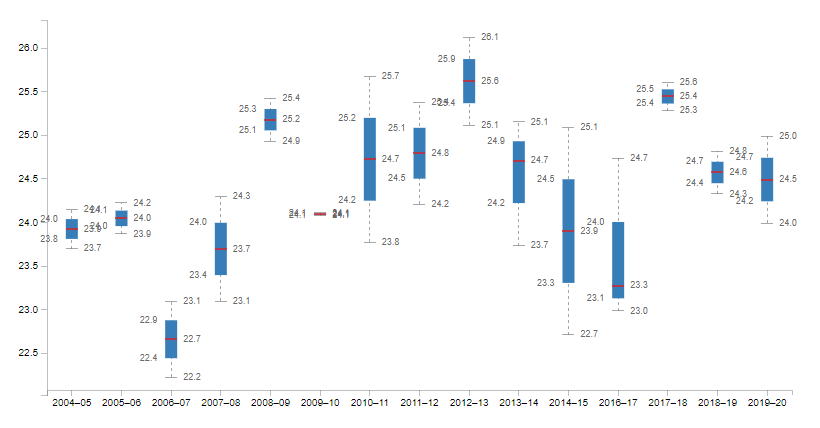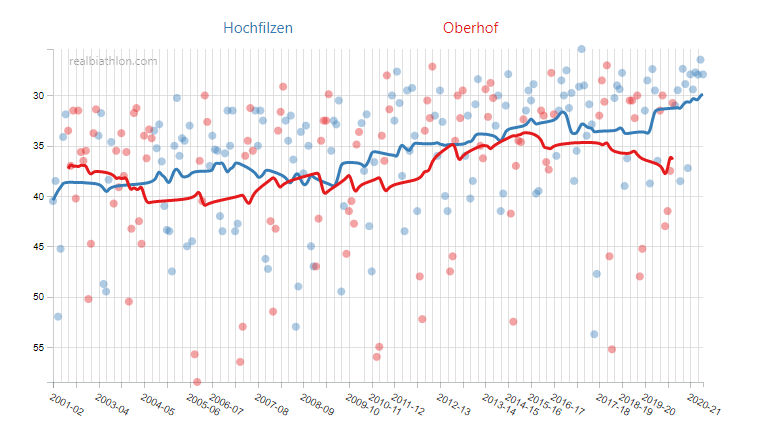During the Christmas break, I worked on compiling a new data set: Statistics for each World Cup location. The full stats are available as bonus content (if you are interested in that you might have a look at the real biathlon Patreon page). Here’s a summary and some examples.
The upcoming World Cup stop, Oberhof, is probably not the most popular location among athletes, due to its notoriously bad weather, but the Oberhof shooting range (in parts because of the weather) has always been one of the most interesting. Here’s the data to back that up. Not only is Oberhof the venue with the lowest average hit rate (75.1%), it also has the highest average shooting time (36.8s) of regular World Cup venues (not including Brezno-Osrblie, which held its last race in 2006, when shooting times where generally slower than they are now).
All-time shooting results for regular Biathlon World Cup venues
| Venue | Nation | First
Year | Last
Year | Races | Total
hit rate
(in %) | Prone
hit rate
(in %) | Standing
hit rate
(in %) | Shooting
Time
(in sec) | Prone
Time
(in sec) | Standing
Time
(in sec) |
|---|
| Antholz-Anterselva | ITA | 1975 | 2020 | 238 | 77.6 | 81.2 | 74.1 | 32.9 | 33.5 | 31.9 |
| Ruhpolding | GER | 1978 | 2020 | 235 | 80.6 | 83.9 | 77.4 | 32.9 | 33.6 | 32.3 |
| Hochfilzen | AUT | 1978 | 2021 | 189 | 78.3 | 81.6 | 75.1 | 35.4 | 36.1 | 34.7 |
| Oslo Holmenkollen | NOR | 1983 | 2019 | 172 | 80.0 | 82.5 | 77.6 | 30.5 | 31.8 | 29.2 |
| Oestersund | SWE | 1970 | 2020 | 168 | 78.4 | 81.8 | 75.1 | 35.3 | 37.5 | 33.1 |
| Oberhof | GER | 1984 | 2020 | 161 | 75.1 | 78.9 | 71.4 | 36.8 | 36.7 | 36.4 |
| Pokljuka | SLO | 1993 | 2020 | 150 | 79.6 | 82.9 | 76.3 | 33.7 | 33.4 | 34.1 |
| Kontiolahti | FIN | 1990 | 2021 | 95 | 78.5 | 81.7 | 75.4 | 33.5 | 34.2 | 32.4 |
| Khanty-Mansiysk | RUS | 2000 | 2016 | 79 | 79.2 | 82.3 | 76.1 | 32.9 | 33.5 | 32.2 |
| Brezno-Osrblie | SVK | 1996 | 2006 | 60 | 79.5 | 82.9 | 76.1 | 38.4 | 35.3 | 41.4 |
| Lahti | FIN | 1980 | 2007 | 55 | 78.7 | 80.8 | 76.5 | 31.6 | 33.1 | 30.0 |
| Nove Mesto | CZE | 2012 | 2020 | 41 | 79.2 | 82.8 | 75.7 | 31.6 | 32.6 | 30.6 |
| PyeongChang | KOR | 2008 | 2018 | 33 | 77.8 | 81.3 | 74.3 | 34.8 | 35.4 | 34.2 |
| Canmore | CAN | 1987 | 2019 | 27 | 76.8 | 79.5 | 74.1 | 34.5 | 35.5 | 33.5 |
| Soldier Hollow, Utah | USA | 2001 | 2019 | 20 | 80.5 | 83.9 | 77.2 | 33.8 | 34.3 | 33.3 |
| Annecy-Le Grand Bornand | FRA | 2014 | 2020 | 18 | 83.2 | 85.8 | 80.7 | 28.9 | 30.1 | 27.7 |
| Sochi | RUS | 2013 | 2014 | 17 | 83.6 | 86.0 | 81.1 | 30.7 | 31.5 | 29.9 |
| Cesana San Sicario | ITA | 2005 | 2006 | 16 | 78.1 | 80.9 | 75.4 | 34.1 | 35.3 | 32.9 |
| Whistler | CAN | 2009 | 2010 | 16 | 82.1 | 84.9 | 79.4 | 33.4 | 34.0 | 32.8 |
| Fort Kent, ME | USA | 2004 | 2011 | 12 | 81.1 | 84.2 | 78.0 | 29.2 | 30.6 | 27.8 |
| Presque Isle, ME | USA | 2011 | 2016 | 11 | 76.9 | 80.6 | 73.2 | 33.9 | 34.8 | 32.9 |
| Trondheim | NOR | 2009 | 2009 | 6 | 83.3 | 85.6 | 80.9 | 29.0 | 30.4 | 27.7 |
| Tyumen | RUS | 2018 | 2018 | 6 | 83.7 | 85.5 | 81.9 | 28.6 | 29.8 | 27.4 |
Although I didn’t include the data here, it’s worth pointing out that Oberhof isn’t just challenging at the range, it also has one of the most difficult and selective tracks: on average, 13.1 of the top 30 athletes ski outside a +/- 30 sec range of the median – also the highest for any venue with more than 30 World Cup races.
The other German location, Ruhpolding, is almost the polar opposite; arguably the easiest regular World Cup range (average shooting percentage of 80.6%). Le Grand Bornand has an even higher hit rate (83.2%), but has also staged over 200 races less; it’s likely that percentage will regress to the mean at least somewhat if more events are held there. Antholz is noteworthy as well, having a relatively fast average shooting time, but a poor average hit rate; apparently the nice weather there combined with the altitude is deceptive.
 Overall hit rate (including relays) | Oberhof vs. Hochfilzen
Overall hit rate (including relays) | Oberhof vs. HochfilzenIn the chart above you can see a comparison for overall hit rates (per race, 10 race moving average) for the last and the upcoming World Cup stops. Hochfilzen (on average) had roughly 5% better shooting results in the last 15 years.
 Ski Speed (in km/h) in Oberhof | Men’s Non-Team races
Ski Speed (in km/h) in Oberhof | Men’s Non-Team racesHere’s the winner’s ski speed (in km/h) for men’s non-team events in Oberhof. Clearly, there are huge differences between seasons (a good example why the physical speed isn’t a great data point for long-term ski speed comparisons).
 Total Shooting Time comparison | Hochfilzen vs. Oberhof
Total Shooting Time comparison | Hochfilzen vs. OberhofLastly, I added a chart of the average total shooting times (per race, 10 race moving average). Hochfilzen and Oberhof are actually closer in that category, however, the shooting times in Hochfilzen got faster over the last decade, while there is no such trend in Oberhof.
About Post Author
Creator of the website realbiathlon.com